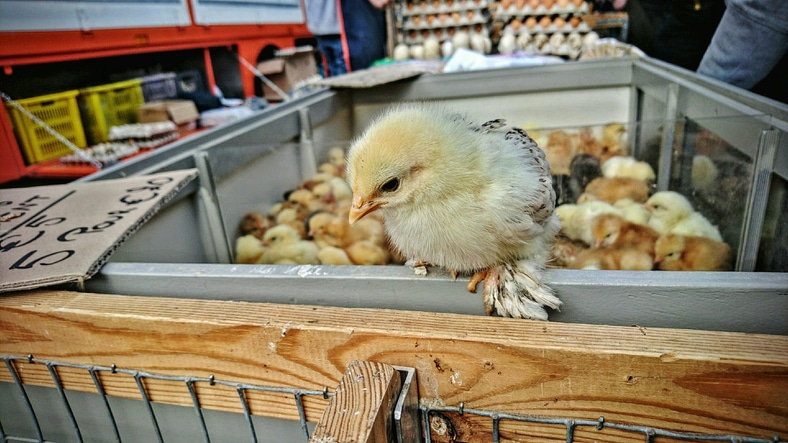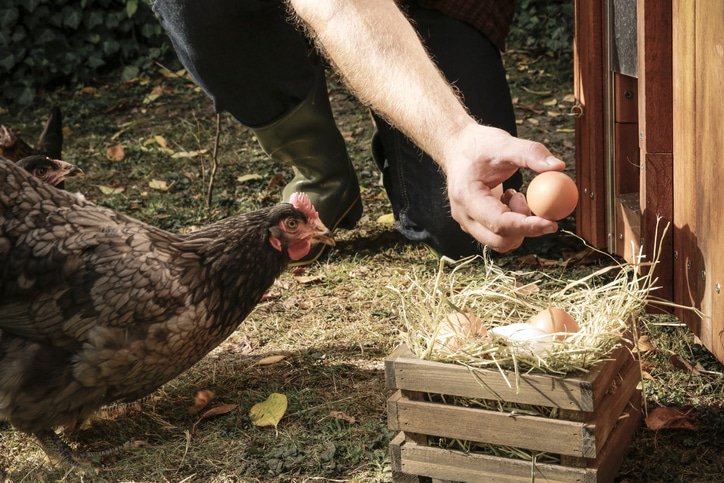Backyard Chickens: Where to Start?

 Why you can trust us
Why you can trust us
Founded in 2005 as an Ohio-based environmental newspaper, EcoWatch is a digital platform dedicated to publishing quality, science-based content on environmental issues, causes, and solutions.
There’s nothing like a farm-fresh egg — or, maybe a backyard-fresh egg.
You don’t need a farm-sized plot of land to raise a few chickens, since even a small, urban backyard will do. Raising the birds and collecting your own eggs is not only an educational, entertaining experience for children, but is also a great way to mitigate the environmental impact of your diet.
If you’re looking to raise a few hens and harvest your own, backyard-fresh eggs, here’s how to get started.
The Basics
Before beginning your backyard-chicken adventure, there are a few things to keep in mind. Consider the time requirements of raising chickens: hens require year-round care, and can’t be left alone for too long. If you go away, you’ll need a chicken sitter the same way you’d need a pet sitter.
Also consider the lifespan of chickens and how many you’ll be able to care for. Chickens are social creatures and need interaction, so between three and six birds is ideal for beginners. Relatively speaking, the egg-laying years of hens are rather limited. Hens generally live 5-7 years (although some can live 10-15 years!), and the first two or three years are the most productive, after which their egg production will taper off. If you want a steady supply of eggs, you’ll want to add younger chickens over time.
Why Raise Your Own Chickens?
Raising chickens has many benefits, both environmental and personal. By producing your own eggs, you’ll no longer be participating in the industrial agriculture system that’s notorious for its inhumane and unsustainable practices. Many large egg producers are notorious for killing unproductive hens, and, while the percentage of cage-free chickens has grown exponentially — from 4% to 28% between 2010 and 2020, according to PBS — that still leaves hundreds of millions of commercial laying hens in confined spaces with little-to-no access to fresh air.
Factory-farmed eggs also have a large environmental footprint. The excessive manure produced by hens delivers more nutrients to the soil than it can handle. The excess nitrogen and phosphorus eventually seeps into the groundwater supply, causing algal blooms and die-off of species, reports Food Print. Hen houses also release noxious gasses like ammonia that pollute the air and can cause respiratory illnesses in poultry workers and nearby communities. The packaging, transportation, and storage of eggs also creates waste and emissions along the way, which you can avoid by keeping the entire system local to your own backyard!

Chickens are very beneficial to gardeners as well. Let them loose in your (enclosed) yard, where they will eat all kinds of unwanted insects, fallen/spoiled produce, and dead stalks. You can even add their manure to the compost, as long as it reaches 130-150º, which will effectively kill any bacteria.
Learning the Laws
The laws around owning backyard chickens vary widely by location, and should be consulted before purchasing chicks or erecting a coop. The last thing you’d want would be to invest your time and money into chickens only to learn that they’re not allowed in your city.
Different rules about keeping chickens are in place at the state, county, and town levels, and are often impacted by zoning. These rules typically regulate the number of chickens you can have, their sex (many places don’t allow roosters), and how close they can be to roads and buildings. Some municipalities even require registration or permits to be issued. Before beginning, take other laws about noise and pests — like rats, which love to nest under coops — into account. If there are strict rules about noise in your neighborhood, a large flock of birds might violate them.
If you’re unsure of the legality of raising chickens in your area, lawyers specializing in zoning and ordinances can be a helpful resource.
Purchasing Chicks
Finding chicks will look a bit different depending on your location. In areas with widespread agriculture, check out local farm supply stores and breeders. Otherwise, many hatcheries sell chicks online and ship them to your doorstep (yes, in the mail!). You’ll also want to determine which breed is best for your climate, spatial constraints, and egg-production needs. Consult this chart from Michigan State University’s College of Agriculture and Natural Resources to find the best breed for your circumstances.

Setting Up
Choosing the perfect spot for your coop is an important first step. The birds will need access to some shade and a good deal of bright light: 14-16 hours a day, in fact, to lay eggs (occasional cloudy conditions can’t be helped). The coop should also be placed on high ground to prevent flooding and dampness, as well as keep the birds safe from predators like foxes, raccoons, dogs, snakes, and coyotes. If you don’t have high ground in your yard, raising the coop up on cinder blocks or stilts should do the trick.
Chickens need both indoor and outdoor space to thrive. When choosing a space, remember you’ll need room for water, feeding troughs, and some empty outdoor space for them to run around. Generally, you should plan for 3-4 square feet inside and at least 8 outside per chicken. Lack of space will cause diseases to spread faster and the chickens will be more likely to peck and harm one another, so giving them sufficient space is crucial. Some people choose to elevate the coop by a few feet and fence in the area underneath if available yard space is minimal. Hens also like to bathe themselves in dust, so leaving room for a small box of sand or fine dirt in the yard will allow them to clean themselves.
Pre-made coops are plentiful online and in stores, or you can design your own. All materials used should be non-toxic and non-corrosive, like plywood: a preferable option for coops, although the legs should be pressure-treated to prevent rotting if the coop is elevated. Every coop should have a roosting area for birds to perch in the rafters (about two feet up from the ground, 8-10 inches per bird), and nesting areas (usually one square-foot box per three chickens, positioned low in the coop). Fill the nesting boxes and cover the ground in straw or sawdust to protect the eggs. You’ll also need separate doors for both yourself and the chickens, adding a ramp if the door is high off the ground. Cut holes near the ceiling for ventilation, and cover them with hardware cloth to prevent predators from entering. Raccoons are especially clever and adept at finding their way into coops, and can open all kinds of locks. Padlocks, carabiners, and other spring and barrel-style locks are safest for locking up at night.
Electricity isn’t necessarily essential for the hen house. Chickens can handle lower temperatures, so you don’t need to heat the coop (unless you live in an extremely cold climate), although a low wattage light bulb might help prolong the laying season as the days get darker.
Expect set-up costs in the range of $500-$700, says Almanac, although costs drop after the first year.
Chicken Care
Chickens are relatively low-maintenance farm animals, but they do require daily care. Here are the basic daily, weekly, monthly, and yearly tasks you can expect.
Daily:
- Check the water supply. Refill and refresh the water every day, especially if it’s been contaminated with dirt or feces.
- Feeding. Put food in the feeding trough every day, or try a hanging feeder. For a flock of six, expect to buy at least one 50-pound bag of quality chicken feed every month, reports Country Living, which should run you about $50. Hens aren’t picky eaters, and while commercial feed contains most of the vitamins and minerals they need, supplementing the hens’ diet — especially during the cold months when they’re not foraging outdoors as much — is important. Most fruits and vegetables, berries, grains, leafy greens, and cooked beans are good supplemental foods. Certain things are toxic to the birds, however, such as onions, rhubarb, avocado, and citrus. Be sure to research specific foods before throwing them in the pen.
- Collect eggs (during laying season). Checking the coop for eggs every morning and evening prevents them from getting cracked.
- Check up on chickens. Make sure they are not injured, and look bright-eyed and alert. Their feathers should be shiny and smooth, and their comb should be red. Monitor their typical gait during the first few weeks so you can notice injuries or inconsistencies in their walk.
Weekly:
- Clean out the water and food toughs with a 10-to-1 mixture of water and bleach, then scrub with dish soap and water.
Monthly:
- Change the bedding every month in small coops, or add a few inches every month in larger coops, then clean out completely every six months (otherwise known as the “deep-litter method”). You should also clean out the nest boxes and add new straw or sawdust.
Yearly:
- Clean the coop thoroughly once or twice a year. Take out everything that can be removed and completely sanitize with the same water-bleach mixture. Check for any necessary repairs, and ensure that ventilation is still functional.
Besides caring for their physical needs, it’s important to care for the emotional needs of your chickens as well. These sentient creatures are proven to have complex positive and negative emotions, and benefit from human touch and entertainment. Put some toys in their pen, like plastic balls with bells inside, and old CDs for them to peck at and interact with their reflection. In the fall, leave piles of raked leaves in their outdoor area for them to rustle around and find bugs in. Chasing food like mealworms and crickets (which you can buy at most pet stores) is fun for them too. Some people even hang small chicken swings or add ladders in the coop to keep the birds entertained.
Eggs
Lastly, collect your prized eggs! Hens will begin to lay eggs — usually one per day — after about 20-24 weeks. Check the entire coop every morning and evening, including inside the nesting boxes. To collect the eggs from underneath a hen, gently shoo the bird away, or carefully pick them up.

Freshly laid eggs don’t have to be refrigerated. Eggs are coated in a natural “bloom” that protects the egg from any bacteria entering, which is eliminated once it’s washed. After collecting your eggs, they can be kept (unwashed) on the counter for several weeks, although you should wash them directly before using. While the U.S. typically sells refrigerated eggs, it’s common in other countries to sell them unwashed — in fact, the European Union prohibits egg producers from washing their eggs.
Subscribe to get exclusive updates in our daily newsletter!
By signing up, you agree to the Terms of Use and Privacy Policy & to receive electronic communications from EcoWatch Media Group, which may include marketing promotions, advertisements and sponsored content.

 233k
233k  41k
41k  Subscribe
Subscribe 




